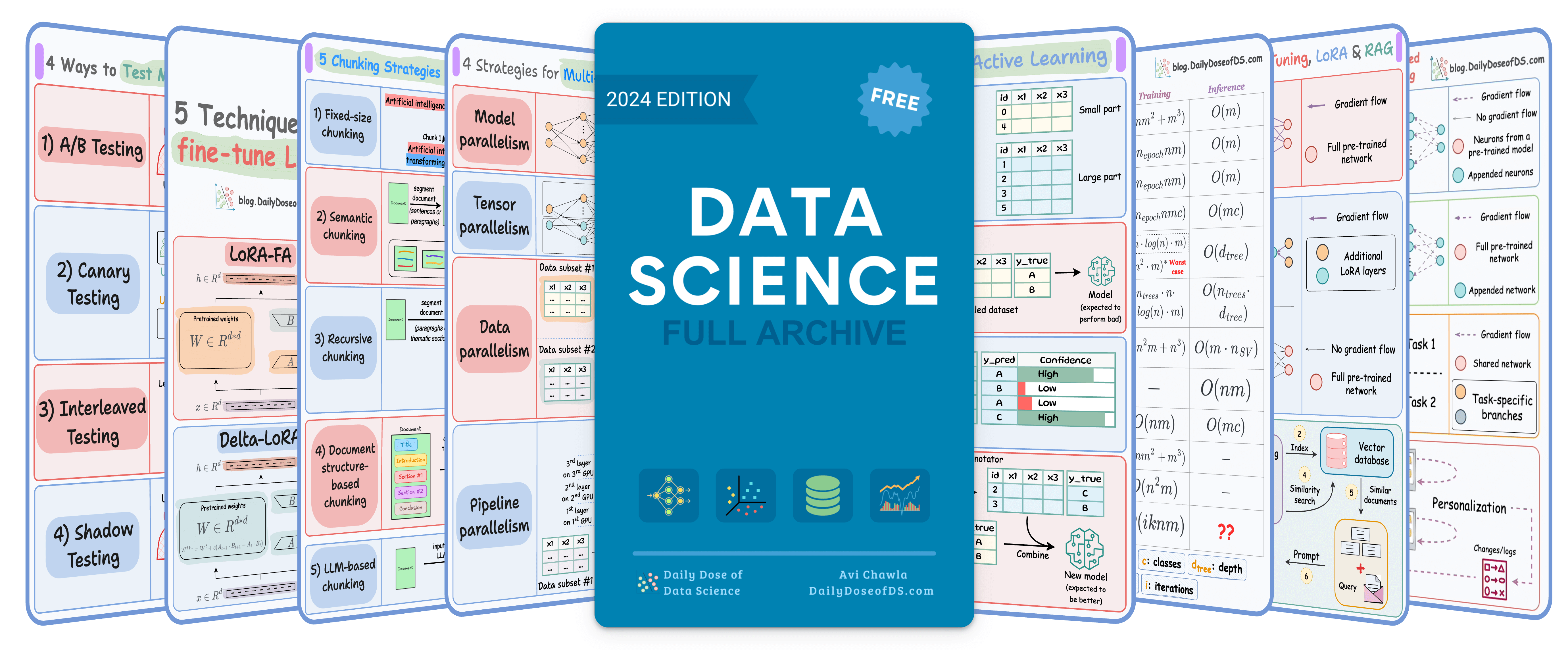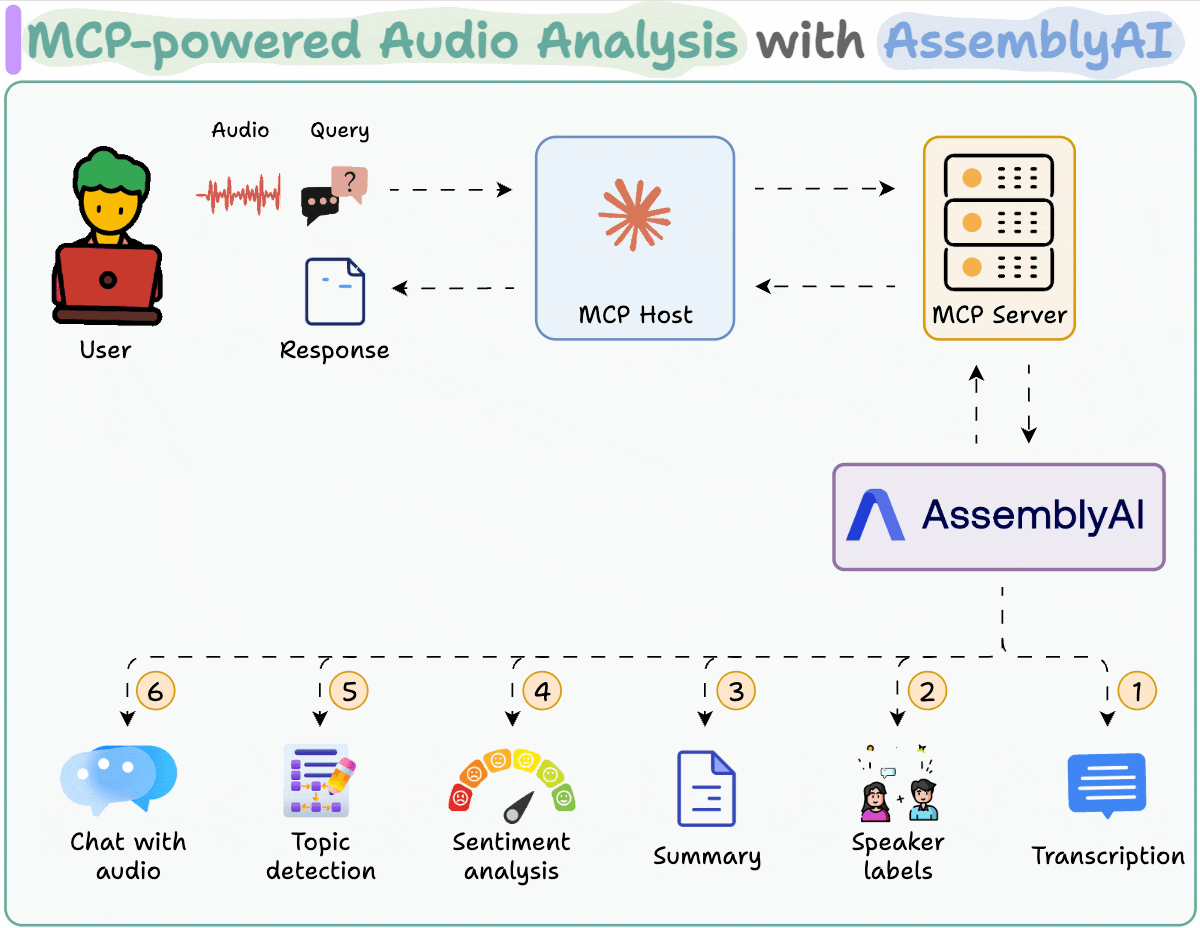

TODAY'S ISSUE
TODAY’S DAILY DOSE OF DATA SCIENCE
[Hands-on] Build an MCP-powered Audio Analysis Toolkit
Today, we are releasing another MCP demo, which is an MCP-driven Audio Analysis toolkit that accepts an audio file and lets you:
1. Transcribe it
2. Perform sentiment analysis
3. Summarize it
4. Identify named entities mentioned
5. Extract broad ideas 6. Interact with it
…all via MCPs.
Here’s our tech stack:
- AssemblyAI for transcription and audio analysis.
- Claude Desktop as the MCP host.
Here's our workflow:

- User's audio input is sent to AssemblyAI via a local MCP server.
- AssemblyAI transcribes it while providing the summary, speaker labels, sentiment, and topics.
- Post-transcription, the user can also chat with audio.
Let’s implement this!
Transcription MCP tool
This tool accepts an audio input from the user and transcribes it using AssemblyAI.
We also store the full transcript to use in the next tool.

Audio analysis tool
Next, we have a tool that returns specific insights from the transcript, like speaker labels, sentiment, topics, and summary.
Based on the user’s input query, the corresponding flags will be automatically set to True when the Agent will prepare the tool call via MCP:

Create MCP Server
Now, we’ll set up an MCP server to use the tools we created above.

Integrate MCP server with Claude Desktop
Go to File → Settings → Developer → Edit Config and add the following code.

Once the server is configured, Claude Desktop will show the two tools we built above in the Tools menu:

- transcribe_audio
- get_audio_data
And now you can interact with it:
We have also created a Streamlit UI for the audio analysis app.
You can upload the audio, extract insights, and chat with it using AssemblyAI’s LeMUR.
And that was our MCP-powered audio analysis toolkit.
Here's the workflow again for your reference:

- User-provided audio is sent to AssemblyAI through the MCP server.
- AssemblyAI processes it, MCP host returns requested insights.
Interview question
Discriminative vs. Generative Models
Here’s a visual that depicts how generative and discriminative models differ:
We have seen this topic come up in several interviews, so let’s learn more.
Discriminative models:
- learn decision boundaries that separate different classes.
- maximize the conditional probability: P(Y|X) — Given X, maximize the probability of label Y.
- are specifically meant for classification tasks.
Generative models:
- maximize the joint probability: P(X, Y)
- learn the class-conditional distribution P(X|Y)
- are typically not preferred to solve downstream classification tasks.
Since generative models learn the underlying distribution, they can generate new samples. But this is not possible with discriminative models.
Furthermore, generative models possess discriminative properties, i.e., they can be used for classification tasks (if needed). But discriminative models do not possess generative properties.
Agent protocols
MCP and A2A, explained visually
In a gist:
- Agent2Agent (A2A) protocol lets AI agents connect to other Agents.
- Model context protocol lets AI Agents connect to Tools/APIs.
So using A2A, while two Agents might be talking to each other...they themselves might be communicating to MCP servers.
In that sense, they do not compete with each other.
The thing about A2A protocol is that Agents can communicate and collaborate with other Agents, even if they built on different platforms or frameworks.
- In MCP, tools (functions) are represented with docstrings.
- In A2A, Agents are represented using an Agent Card, which is a JSON file that lists the Agent's capabilities, input, authentication schemes, etc.
For practical details, we built an Agent network with A2A Protocol here →
THAT'S A WRAP
No-Fluff Industry ML resources to
Succeed in DS/ML roles

At the end of the day, all businesses care about impact. That’s it!
- Can you reduce costs?
- Drive revenue?
- Can you scale ML models?
- Predict trends before they happen?
We have discussed several other topics (with implementations) in the past that align with such topics.
Here are some of them:
- Learn sophisticated graph architectures and how to train them on graph data in this crash course.
- So many real-world NLP systems rely on pairwise context scoring. Learn scalable approaches here.
- Run large models on small devices using Quantization techniques.
- Learn how to generate prediction intervals or sets with strong statistical guarantees for increasing trust using Conformal Predictions.
- Learn how to identify causal relationships and answer business questions using causal inference in this crash course.
- Learn how to scale and implement ML model training in this practical guide.
- Learn 5 techniques with implementation to reliably test ML models in production.
- Learn how to build and implement privacy-first ML systems using Federated Learning.
- Learn 6 techniques with implementation to compress ML models.
All these resources will help you cultivate key skills that businesses and companies care about the most.
SPONSOR US
Advertise to 600k+ data professionals
Our newsletter puts your products and services directly in front of an audience that matters — thousands of leaders, senior data scientists, machine learning engineers, data analysts, etc., around the world.






